► Porsche’s Taycan GTS is back – and better than ever
► Benefits from standard car’s recent range of tweaks
► More power, more range and faster charging times
If you didn’t see this one coming, you might want to get your eyes tested. Porsche improved every other model in the Taycan range earlier this year with better battery technology and snappier electric motors – and it’s now peppered the same improvements over the GTS.
That’s made a fast EV even faster. This new Taycan GTS has 690bhp, which is a whopping 100bhp more than the previous version of the car. The extra poke means it can now sprint from 0–62mph in just 3.3 seconds (0.4 seconds faster than before) and thrash from 0–124mph in 10.4 seconds (a whopping 1.6 seconds faster than the old car).
It also benefits from the same battery improvements as the rest of the Taycan range. We’ll explain them in greater detail below, but the upshot is that the car can now drive a further 74 miles before running out of electricity. According to the WLTP cycle, anyway.
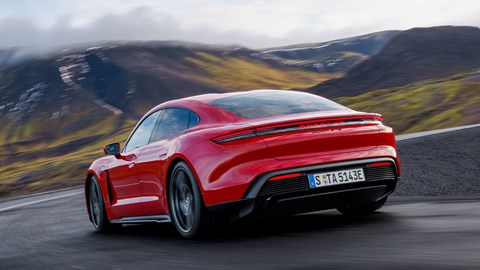
To set the GTS apart from its sister cars, it gets 20-inch alloy wheels, Matrix LED headlights, some slightly sportier front and rear aprons (painted black, naturally), a pair of deeper GTS-branded sports seats and some choice ‘GTS’ badges on the boot lid and treadplates.
The chassis gets a couple of tweaks, too. You get adaptive dampers and torque vectoring as standard, although you can specify Porsche’s snazzy Active Ride suspension as an optional extra. Porsche has also designed a unique EV sound profile to suit the GTS.
The Taycan GTS is available to order now – and you can have it as either a saloon or an estate (which is infinitely cooler in our opinion). The former costs £117,500, while the latter will set you back £118,300. First deliveries are expected to arrive in early 2025.
What did Porsche update on the Taycan?
Quite a lot. So much, in fact, that Porsche felt it necessary to rebrand the car’s platform. The updated car’s architecture is dubbed J1 II, as opposed to the original car’s J1 branding.
Range matters, and the new Taycan has a decent chunk more of it thanks to increased efficiency and an upgrade for its bigger Performance Battery Plus, up to 105kWh gross and 97kWh usable. An all-new unit with new cell chemistry, it brings increased power density, more current and reduced sensitivity to temperature – handy for rapid charging in colder climes.
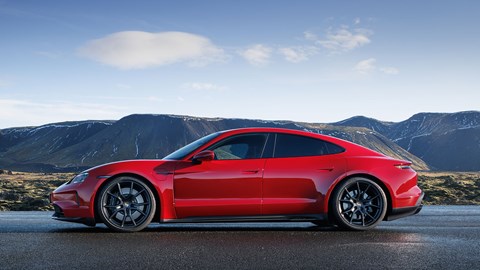
It flows energy to (and from) a lighter, more compact and more powerful electric motor, driving a car that’s a smidge lighter than the first-gen Taycan (by around 15kg, despite a more lavish level of standard equipment) and a good chunk more efficient.
WLTP power consumption is now 3.45 miles per kWh for the tyre-melting Turbo S (versus 2.84 miles per kWh for the current car) and 3.72 miles per kWh (versus 3.17) for the charge-sipping, single-motor Taycan. Together with the bigger battery, that means range is up by around 35% depending on the model. The Turbo S saloon goes from 291 miles to 391 miles WLTP, while the single-motor, rear-drive Taycan with the optional bigger battery climbs from around 313 miles to a hefty 421.
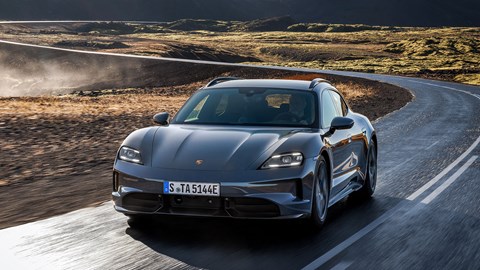
‘Do they, though?’ I hear you cry – and congratulations on your healthy cynicism. The answer of course is no, they do not. The true figure? A week before the car’s global reveal we climbed behind the wheel of a single-motor model on low-drag 19-inch wheels and pointed it south from LA to San Diego to find out.
A few hours later we’d managed 365 miles without charging, the consumption read-out showing mostly 3.6 miles per kWh. That’s not 421 miles or 3.72 miles per kWh, granted, but it’s within a sniff of the official consumption figures – and impressive when you consider the improvement over the first-gen car. And let’s not forget, it’s a high-performance EV.
The Taycan continues with three body styles (saloon, Sport Turismo and Cross Turismo) and more electric motor options than a Tamiya R/C car. The rear-drive, single-motor saloon is up to £86,500 (up from £79,200), the popular 4S £95,900 (up from £90,700) and the Turbo S £161,400 (up from £148,300).
Faster – and faster charging
Did anyone ask for a faster Taycan? No matter. Porsche has built one anyway, upgrading the entire powertrain to boost the Turbos S by 188bhp to 939bhp and the rear-drive car by 80bhp to 402bhp. That’s enough to drop the Turbo S’s 0–62mph time to a breakfast-churning 2.4sec, and the single-motor car’s to a hardly-tardy 4.8sec.
But if you’re hunting for the most efficient means of jettisoning the contents of your stomach, you’re going to want the Turbo GT. It has a scarcely believable 1020bhp and a 0–62mph time of just 2.3 seconds. That’s enough to demolish most supercars. Wondering what it’s like? Wonder no longer, because we’ve been driving it.
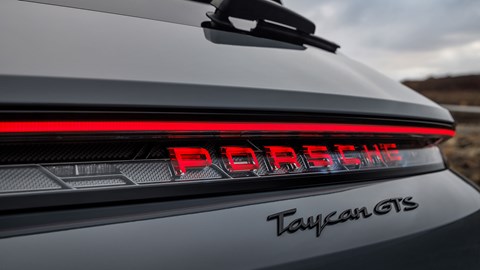
The new model promises to be faster around corners too, having ditched the previous car’s 48-volt roll control system for a version of the Panamera’s electro-hydraulic Active Ride. Air suspension is now also standard, and in too come Porsche’s new two-valve dampers. Our limited experience to date (a twisty-road passenger ride in Germany and the freeway drive in California) would suggest the ride is more compliant and the body control as resolute as ever.
Charging capacity is up 50kW, from 270kW to 320kW, and when you can find a suitably powerful charger the results are impressive. We see 320kW on the charger display in both freezing cold Germany and balmy California, and on one charge take on an indicated 46kWh – or 165 miles of range in the rear-drive car – in just eight minutes.
It’s evolved inside
Just as you’d be forgiven for failing to spot the changes externally, so the new Taycan isn’t an entirely different beast inside, either. But things have changed. The car gets new functionality within its charging planner, such as a list of places to eat and shop in the area, video streaming on the passenger screen (blocked from the driver while you’re moving, but gorge on Ted Lasso by all means as you charge), sleeker instrument graphics complete with an indicator of the car’s readiness for charging, and scope for personalisation within each drive mode (selected via a now standard drive mode rotary controller on the steering wheel) rather than a single customisable Individual drive mode.
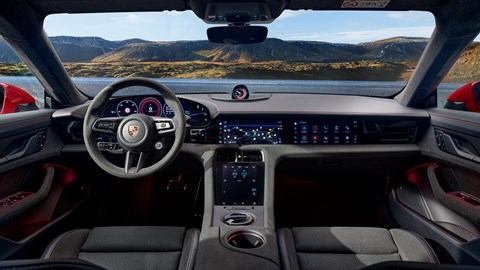
There’s also Porsche’s version of CarPlay, co-developed with Apple, which allows you to do stuff like switch radio stations and set the climate control without having to endlessly head out of CarPlay and into the car’s native infotainment. Informed by data running from the car via the My Porsche app into iOS, there’s also now a charging planner within Apple Maps.
Still top dog? Some rivals are more powerful (for now at least – Porsche’s wild ‘Turbo GT’ Taycan, possibly with three motors, looks to be just around the corner), while others go further. But the Taycan’s winning blend of style, speed and usability looks to have remained intact, while range, efficiency, comfort and power have all headed in the right direction. We’d be amazed if they’ve screwed this up.